Gibberellic Acid Induced Changes on Growth, Yield, Superoxide Dismutase, Catalase and Peroxidase in Fruits of Bitter Gourd (Momordica charantia L.)
Abstract
:1. Introduction
2. Materials and Methods
2.1. Experimental Design
2.2. Collection and Application of GA3
2.3. Vegetative and Reproductive Parameters
2.4. Extraction and Determination of Antioxidant Enzymes
2.5. Statistical Analysis
3. Results and Discussion
3.1. Petiole and Internodal Length
3.2. Fruit Number and Weight
3.3. Yield per Plant
3.4. SOD, POD and CAT
4. Conclusions
Author Contributions
Funding
Conflicts of Interest
References
- Ahmad, N.; Hasan, N.; Ahmad, Z.; Zishan, M.; Zohrameena, S. Momordica charantia: For traditional uses and pharmacological actions. J. Drug Deliv. Ther. 2016, 6. [Google Scholar] [CrossRef]
- Bortolotti, M.; Mercatelli, D.; Polito, L. Momordica charantia, a nutraceutical approach for inflammatory related diseases. Front. Pharmacol. 2019, 10, 486. [Google Scholar] [CrossRef] [Green Version]
- Salehi, B.; Ata, A.; Anil Kumar, V.N.; Sharopov, F.; Ramírez-Alarcón, K.; Ruiz-Ortega, A.; Abdulmajid Ayatollahi, S.; Tsouh Fokou, P.V.; Kobarfard, F.; Amiruddin Zakaria, Z.; et al. Antidiabetic potential of medicinal plants and their active components. Biomolecules 2019, 9, 551. [Google Scholar] [CrossRef] [Green Version]
- Adil, S.A.; Chattha, M.W.A.; Bakhsh, K.; Hassan, S. Profitability analysis of summer vegetables by farm size. Pak. J. Agri. Sci 2007, 44, 184–188. [Google Scholar]
- Mila, F.A.; Rahman, M.S.; Nahar, N.; Debnath, D.; Shahjada, M.K.H. Profitability of bitter gourd production in some areas of Narsingdi District. J. Sylhet Agric. Univ. 2015, 2, 143–147. [Google Scholar]
- Behera, T.K.; Behera, S.; Bharathi, L.K.; John, K.J.; Simon, P.W.; Staub, J.E. Bitter gourd: Botany, horticulture, breeding. Hortic. Rev. 2010, 37, 101–141. [Google Scholar]
- Rasco, A.O.; Castillo, P.S. Flowering patterns and vine pruning effects in bittergourd (Momordica charantia L) varieties “Sta. Rita” and “Makiling.”. Philipp. Agric. 1990, 73, 311–322. [Google Scholar]
- Dey, S.S.; Batters, T.K.; Pal, A.; Munshi, A.D. Correlation and path coefficient analysis in bitter gourd. Veg. Sci. 2005, 32, 173–176. [Google Scholar]
- Li, S.F.; Zhang, G.J.; Yuan, J.H.; Deng, C.L.; Gao, W.J. Repetitive sequences and epigenetic modification: Inseparable partners play important roles in the evolution of plant sex chromosomes. Planta 2016, 243, 1083–1095. [Google Scholar] [CrossRef]
- Lai, Y.-S.; Shen, D.; Zhang, W.; Zhang, X.; Qiu, Y.; Wang, H.; Dou, X.; Li, S.; Wu, Y.; Song, J.; et al. Temperature and photoperiod changes affect cucumber sex expression by different epigenetic regulations. BMC Plant Biol. 2018, 18, 268. [Google Scholar] [CrossRef] [Green Version]
- Girek, Z.; Prodanovic, S.; Zdravkovic, J.; Zivanovic, T.; Ugrinovic, M.; Zdravkovic, M. The effect of growth regulators on sex expression in melon (Cucumis melo L.). Crop. Breed. Appl. Biotechnol. 2013, 13, 165–171. [Google Scholar] [CrossRef]
- Khan, N.; Bano, A.; Babar, M.D.A. Metabolic and physiological changes induced by plant growth regulators and plant growth promoting rhizobacteria and their impact on drought tolerance in Cicer arietinum L. PLoS ONE 2019, 14, e0213040. [Google Scholar] [CrossRef] [PubMed]
- Mishra, S.; Behera, T.K.; Munshi, A.D.; Bharadwaj, C.; Rao, A.R. Inheritance of gynoecism and genetics of yield and yield contributing traits through generation mean analysis in bitter gourd. Indian J. Hortic. 2015, 72, 218–222. [Google Scholar] [CrossRef]
- Pawełkowicz, M.; Pryszcz, L.; Skarzyńska, A.; Wóycicki, R.K.; Posyniak, K.; Rymuszka, J.; Przybecki, Z.; Pląder, W. Comparative transcriptome analysis reveals new molecular pathways for cucumber genes related to sex determination. Plant Reprod. 2019, 32, 193–216. [Google Scholar] [CrossRef] [PubMed] [Green Version]
- Zhang, Y.; Zhao, G.; Li, Y.; Mo, N.; Zhang, J.; Liang, Y. Transcriptomic analysis implies that GA regulates sex expression via ethylene-dependent and ethylene-independent pathways in cucumber (Cucumis sativus L.). Front. Plant Sci. 2017, 8, 10. [Google Scholar] [CrossRef] [Green Version]
- Molaei, A.; Lakzian, A.; Haghnia, G.; Astaraei, A.; Rasouli-Sadaghiani, M.; Ceccherini, M.T.; Datta, R. Assessment of some cultural experimental methods to study the effects of antibiotics on microbial activities in a soil: An incubation study. PLoS ONE 2017, 12, e0180663. [Google Scholar] [CrossRef]
- Molaei, A.; Lakzian, A.; Datta, R.; Haghnia, G.; Astaraei, A.; Rasouli-Sadaghiani, M.; Ceccherini, M.T. Impact of chlortetracycline and sulfapyridine antibiotics on soil enzyme activities. Int. Agrophys. 2017, 31, 499–505. [Google Scholar] [CrossRef] [Green Version]
- Meena, R.S.; Kumar, S.; Datta, R.; Lal, R.; Vijayakumar, V.; Brtnicky, M.; Sharma, M.P.; Yadav, G.S.; Jhariya, M.K.; Jangir, C.K. Impact of agrochemicals on soil microbiota and management: A review. Land 2020, 9, 34. [Google Scholar] [CrossRef] [Green Version]
- Brtnicky, M.; Holatko, J.; Pecina, V.; Kintl, A.; Latal, O.; Vyhnanek, T.; Prichystalova, J.; Datta, R. Long-term effects of biochar-based organic amendments on soil microbial parameters. Agronomy 2019, 9, 747. [Google Scholar] [CrossRef] [Green Version]
- Aya, K.; Ueguchi-Tanaka, M.; Kondo, M.; Hamada, K.; Yano, K.; Nishimura, M.; Matsuoka, M. Gibberellin modulates anther development in rice via the transcriptional regulation of GAMYB. Plant Cell 2009, 21, 1453–1472. [Google Scholar] [CrossRef] [Green Version]
- Song, S.; Qi, T.; Huang, H.; Xie, D. Regulation of stamen development by coordinated actions of jasmonate, auxin, and gibberellin in arabidopsis. Mol. Plant 2013, 6, 1065–1073. [Google Scholar] [CrossRef] [Green Version]
- Benková, E. Plant hormones in interactions with the environment. Plant Mol. Biol. 2016, 91, 597. [Google Scholar] [CrossRef] [PubMed] [Green Version]
- Crow, J.R.; Thomson, R.J.; Mander, L.N. Synthesis and confirmation of structure for the gibberellin GA 131 (18-hydroxy-GA4). Org. Biomol. Chem. 2006, 4, 2532–2544. [Google Scholar] [CrossRef] [PubMed]
- Gupta, R.; Chakrabarty, S.K. Gibberellic acid in plant: Still a mystery unresolved. Plant Signal. Behav. 2013, 8, e25504. [Google Scholar] [CrossRef] [PubMed] [Green Version]
- Anwar, A.; Yan, Y.; Liu, Y.; Li, Y.; Yu, X. 5-Aminolevulinic acid improves nutrient uptake and endogenous hormone accumulation, enhancing low-temperature stress tolerance in cucumbers. Int. J. Mol. Sci. 2018, 19, 3379. [Google Scholar] [CrossRef] [PubMed] [Green Version]
- Hamdy, A. Effect of GA3 and NAA on growth, yield and fruit quality of Washington navel orange. Egypt. J. Hortic. 2017, 44, 33–43. [Google Scholar] [CrossRef]
- Shah, S.-U.-S.; Khan, A.; Khan, M.A.; Farooq, K.; Riaz Chattha, M.; Javed, M.A.; Gurmani, Z.A.; Hussain, A.; Iftikhar, M. Effects of gibberellic acid on growth, yield and quality of grape cv. Perlet 2015, 12, 499–503. [Google Scholar]
- Tantasawat, P.A.; Sorntip, A.; Pornbungkerd, P. Effects of exogenous application of plant growth regulators on growth, yield, and In Vitro gynogenesis in cucumber. HortScience 2015, 50, 374–382. [Google Scholar] [CrossRef] [Green Version]
- Ghani, M.A.; Amjad, M.; Iqbal, Q.; Nawaz, A.; Ahmad, T.; Hafeez, O.B.A.; Abbas, M. Efficacy of plant growth regulators on sex expression, earliness and yield components in bitter gourd. Pakistan J. Life Soc. Sci. 2013, 11, 218–224. [Google Scholar]
- Hossain, D.; Abdul Karim, M.; Rahman Pramanik, M.H.; Syedur Rahman, A.A.M. Effect of |d (GA3) on flowering and fruit development of bitter gourd (Momordica charantia L.). Int. J. Bot. 2006, 2, 329–332. [Google Scholar] [CrossRef]
- Nagmani, S. Studies on Crop Growth and Sex Expression in Relation to Hybrid Seed Production of Bitter Gourd (Momordica charinata L.). Master’s Thesis, Faculty of Post Graduate Schol, IARI, New Delhi, India, 2011. [Google Scholar]
- Marfo, T.D.; Vranová, V.; Ekielski, A. Ecotone dynamics and stability from soil perspective: Forest-agriculture land transition. Agriculture 2019, 9, 228. [Google Scholar] [CrossRef] [Green Version]
- Marfo, T.D.; Datta, R.; Pathan, S.I.; Vranová, V. Ecotone dynamics and stability from soil scientific point of view. Diversity 2019, 11, 53. [Google Scholar] [CrossRef] [Green Version]
- Yadav, G.S.; Datta, R.; Pathan, S.I.; Lal, R.; Meena, R.S.; Babu, S.; Das, A.; Bhowmik, S.N.; Datta, M.; Saha, P.; et al. Effects of conservation tillage and nutrient management practices on soil fertility and productivity of rice (Oryza sativa L.)-rice system in North eastern region of India. Sustainability 2017, 9, 1816. [Google Scholar] [CrossRef] [Green Version]
- Gocmen, M.; Aydin, E.; Simsek, I.; Sari, N.; Solmaz, I.; Gokseven, A. Characterization of some agronomic traits and β-carotene contents of orange fleshed altinbas melon dihaploid lines. Ekin J. Crop Breed. Genet. 2017, 3, 12–18. [Google Scholar]
- Yagoub, S.O.; Ahmed, W.M.A.; Mariod, A.A. Show more effect of urea, NPK and compost on growth and yield of soybean (Glycine max L), in Semi-Arid Region of Sudan. Int. Sch. Res. Not. 2012, 2012, 678124. [Google Scholar]
- El-Kholy, E.; Hafez, H. Response of snake cucumber (Cucumis melo var. pubescens) to some plant regulators. J. Agric. Sci. 1982, 99, 587–590. [Google Scholar] [CrossRef]
- Štajner, D.; Popović, B. Comparative study of antioxidant capacity in organs of different Allium species. Open Life Sci. 2009, 4, 224–228. [Google Scholar] [CrossRef]
- Chance, B.; Maehly, A.C. Assay of catalases and peroxidases. In Methods of Biochemical Analysis; John Wiley & Sons, Inc.: Hoboken, NJ, USA, 1954; Volume 1. [Google Scholar]
- Steel, R.G.; Torrie, J.H.; Dickey, D.A. Principles and Procedures of Statistics: A Biometrical Approach, 3rd ed.; McGraw Hill Book International Co.: Singapore, 1997. [Google Scholar]
- Anandan, A.; Rajiv, G.; Ramarao, A.; Prakash, M. Internode elongation pattern and differential response of rice genotypes to varying levels of flood water. Funct. Plant Biol. 2012, 39, 137–145. [Google Scholar] [CrossRef]
- Amooaghaie, R. The effect mechanism of moist-chilling and GA3 on seed germination and subsequent seedling growth of ferula ovina boiss. Open Plant Sci. J. 2009, 3, 22–28. [Google Scholar] [CrossRef]
- Ullah, R.; Sajid, M.; Ahmad, H.; Luqman, M.; Razaq, M.; Nabi, G.; Fahad, S.; Rab, A. Association of gibberellic acid (GA3) with fruit set and fruit drop of sweet orange. J. Biol. 2014, 4, 54–59. [Google Scholar]
- Bostrack, J.M.; Struckmeyer, B.E. Effect of gibberellic acid on the growth and anatomy of coleus blumei, antirrhinum majus and salvia splendens. N. Phytol. 1967, 66, 539–544. [Google Scholar] [CrossRef]
- Ross, J.J.; O’Neill, D.P.; Rathbone, D.A. Auxin-gibberellin interactions in pea: Integrating the old with the new. J. Plant Growth Regul. 2003, 22, 99–108. [Google Scholar] [CrossRef]
- Ramteke, V.; Paithankar, D.H.; Baghel, M.M.; Kurrey, V.K. Impact of GA3 and propagation media on growth rate and leaf chlorophyll content of papaya seedlings. Res. J. Agric. Sci. 2016, 7, 169–171. [Google Scholar]
- Sadia, S.; Rab, A.; Shah, S.H.A.; Ullah, I.; Bibi, F.; Zeb, I. Influence of De-blossoming and GA3 application on fruit drop and growth of winter guava. Sarhad J. Agric. 2017, 33, 526–531. [Google Scholar] [CrossRef]
- Pan, S.; Rasul, F.; Li, W.; Tian, H.; Mo, Z.; Duan, M.; Tang, X. Roles of plant growth regulators on yield, grain qualities and antioxidant enzyme activities in super hybrid rice (Oryza sativa L.). Rice 2013, 6, 9. [Google Scholar] [CrossRef]
- Whitehead, D.; Edwards, G.R. Assessment of the application of gibberellins to increase productivity and reduce nitrous oxide emissions in grazed grassland. Agric. Ecosyst. Environ. 2015, 207, 40–50. [Google Scholar] [CrossRef]
- Eid, R.A.; Abou-Leila, B.H. Response of croton plants to gibberellic acid, benzyl adenine and ascorbic acid application. World J. Agric. Sci. 2006, 2, 174–179. [Google Scholar]
- Khan, N.A.; Singh, S.; Nazar, R.; Lone, P.M. The source sink relationship in mustard. Asian Australas. J. Plant Sci. Biotechnol. 2007, 1, 10–18. [Google Scholar]
- Zhang, C.; Tanabe, K.; Tamura, F.; Itai, A.; Yoshida, M. Roles of gibberellins in increasing sink demand in Japanese pear fruit during rapid fruit growth. Plant Growth Regul. 2007, 52, 161–172. [Google Scholar] [CrossRef]
- Rosenwasser, S.; Belausov, E.; Riov, J.; Holdengreber, V.; Friedman, H. Gibberellic acid (GA3) inhibits ROS increase in chloroplasts during dark-induced senescence of pelargonium cuttings. J. Plant Growth Regul. 2010, 29, 375–384. [Google Scholar] [CrossRef]
- Liang, Z.; Ma, Y.; Xu, T.; Cui, B.; Liu, Y.; Guo, Z.; Yang, D. Effects of abscisic acid, gibberellin, ethylene and their interactions on production of phenolic acids in salvia miltiorrhiza bunge hairy roots. PLoS ONE 2013, 8, e72806. [Google Scholar] [CrossRef] [Green Version]
- Ahmad, P. Growth and antioxidant responses in mustard (Brassica junceaL.) plants subjected to combined effect of gibberellic acid and salinity. Arch. Agron. Soil Sci. 2010, 56, 575–588. [Google Scholar] [CrossRef]
- Hoad, G.V.; Lenton, J.R.; Jackson, M.B. Hormone Action in Plant Development–A Critical Appraisal; Butterworth-Heinemann: Oxford, UK, 1987. [Google Scholar]
- Wu, L.L.; Mitchell, J.P.; Cohn, N.S.; Kaufman, P.B. Gibberellin (GA3) enhances cell wall invertase activity and mRNA levels in elongating dwarf pea (Pisum sativum) shoots. Int. J. Plant Sci. 1993, 154, 280–289. [Google Scholar] [CrossRef]
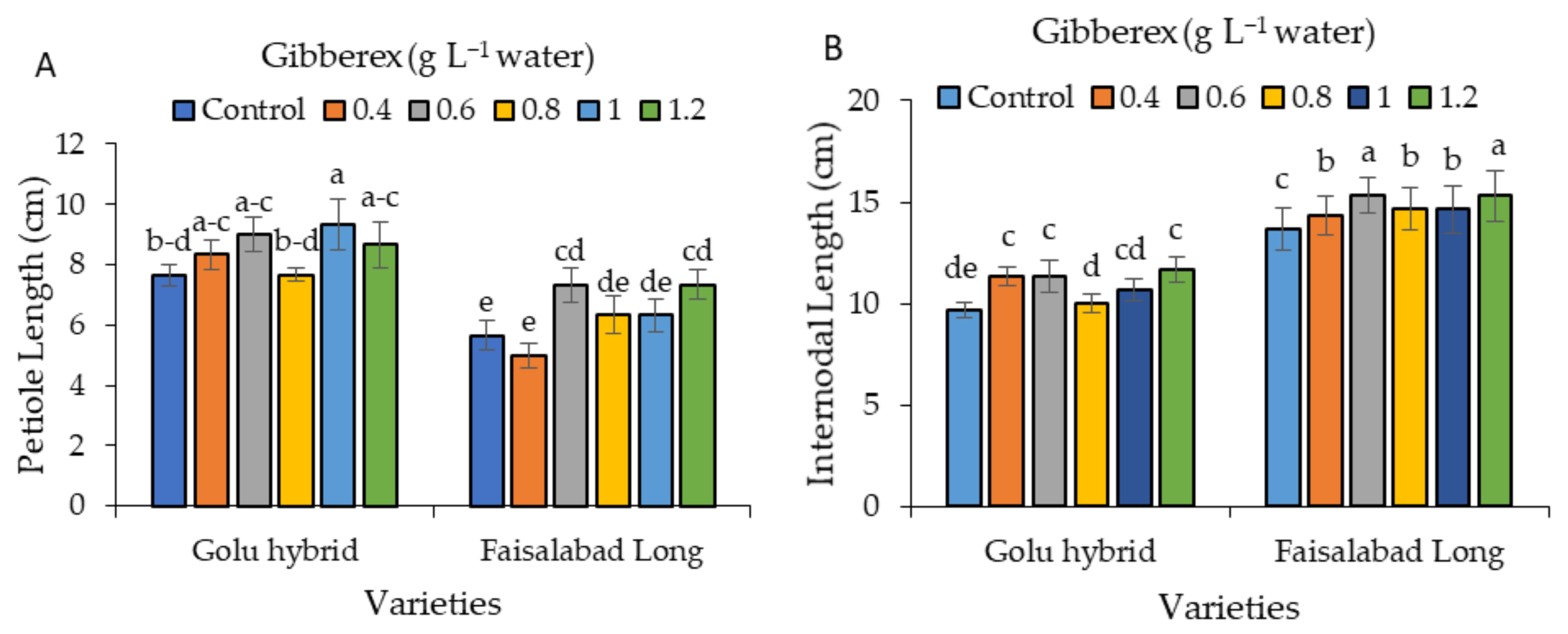
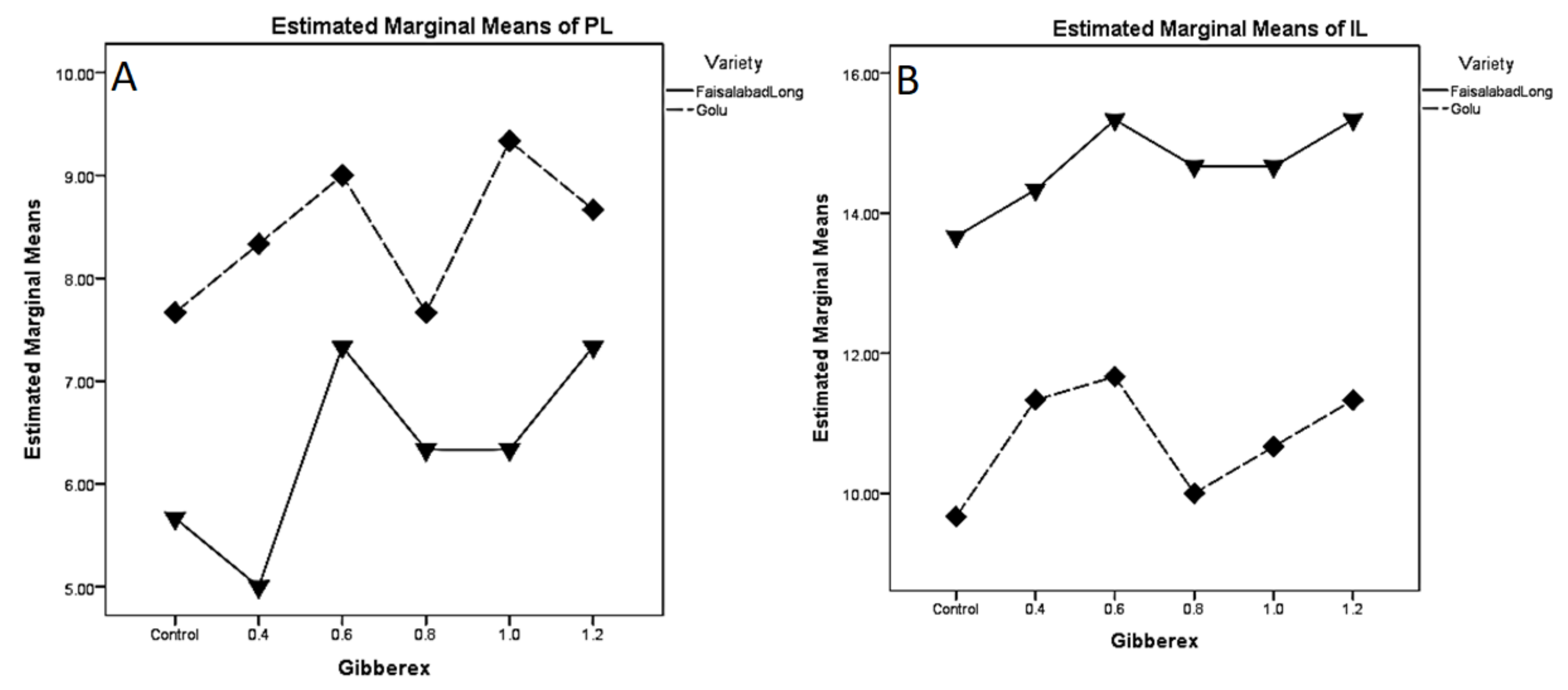


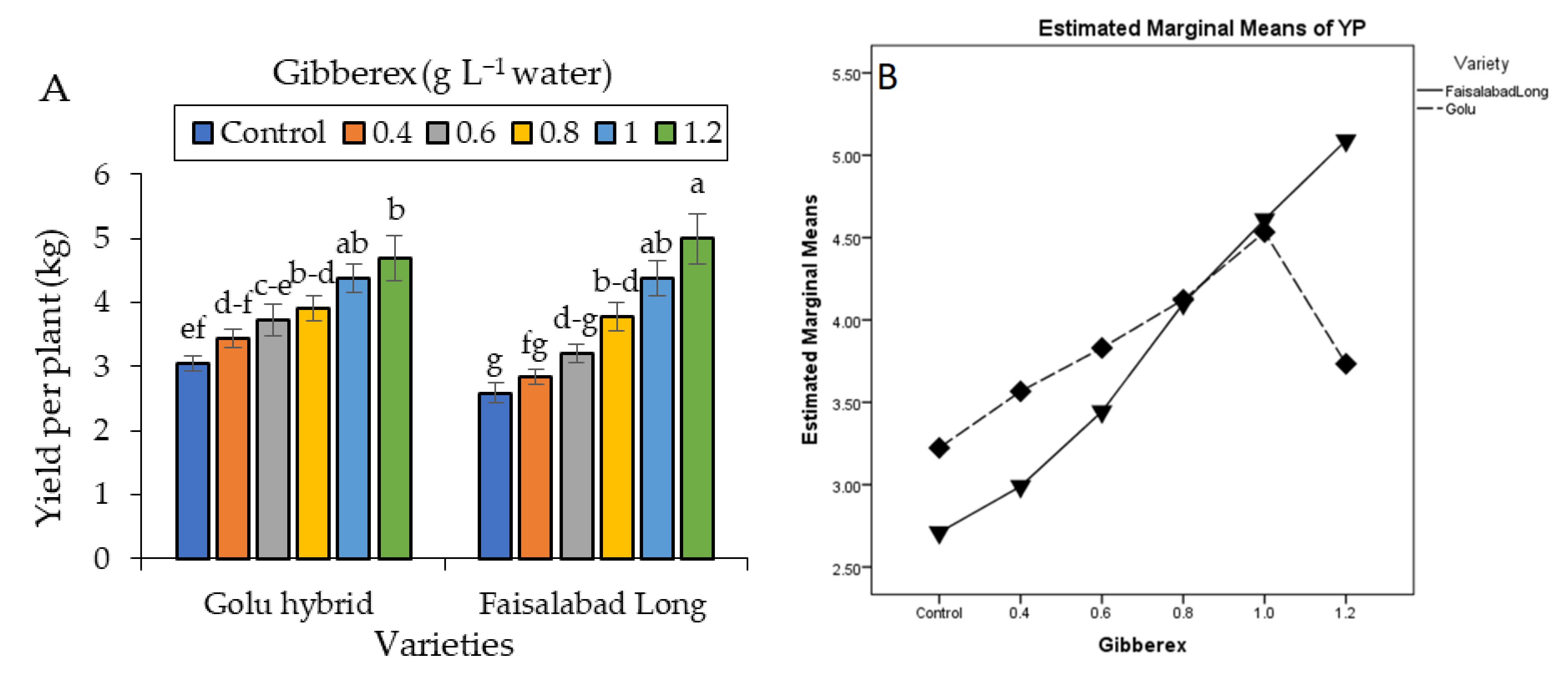
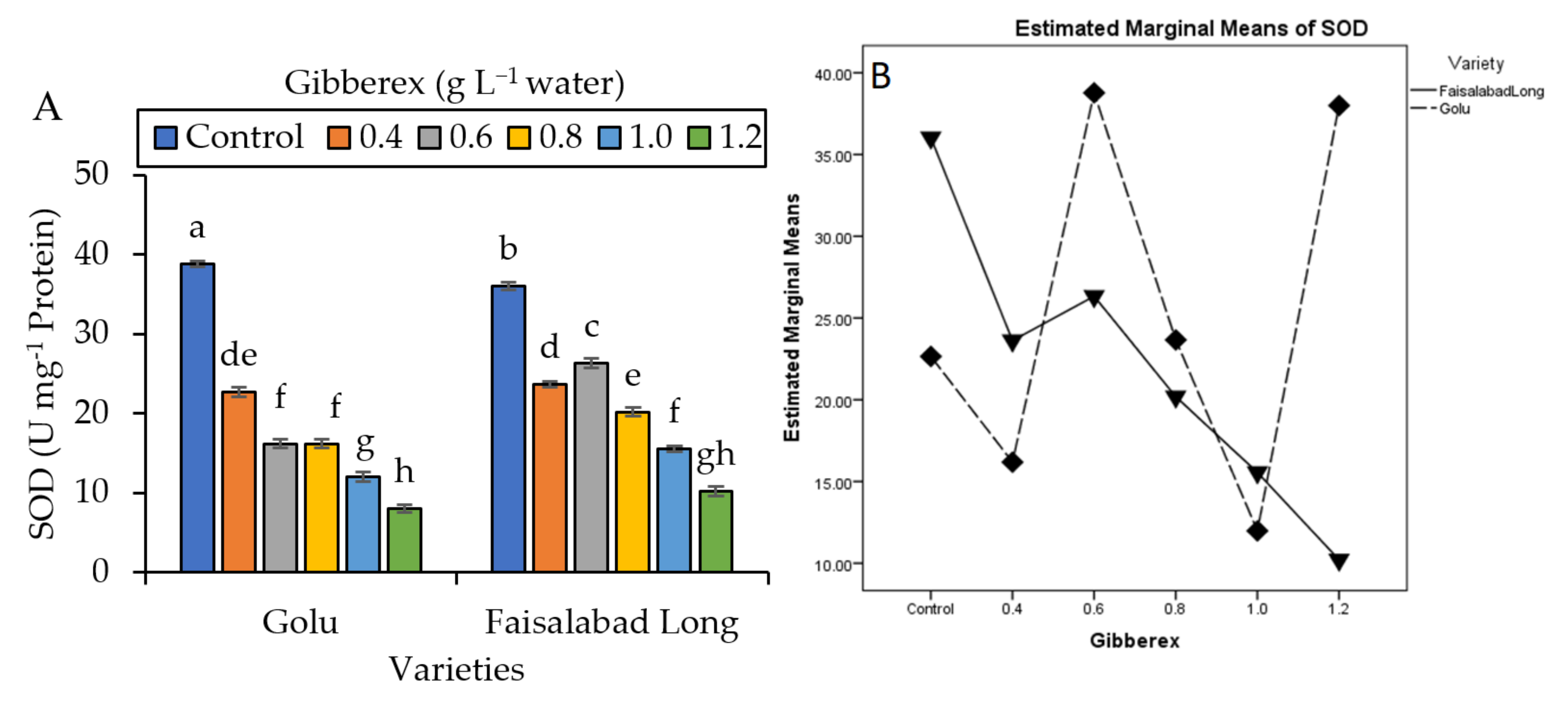
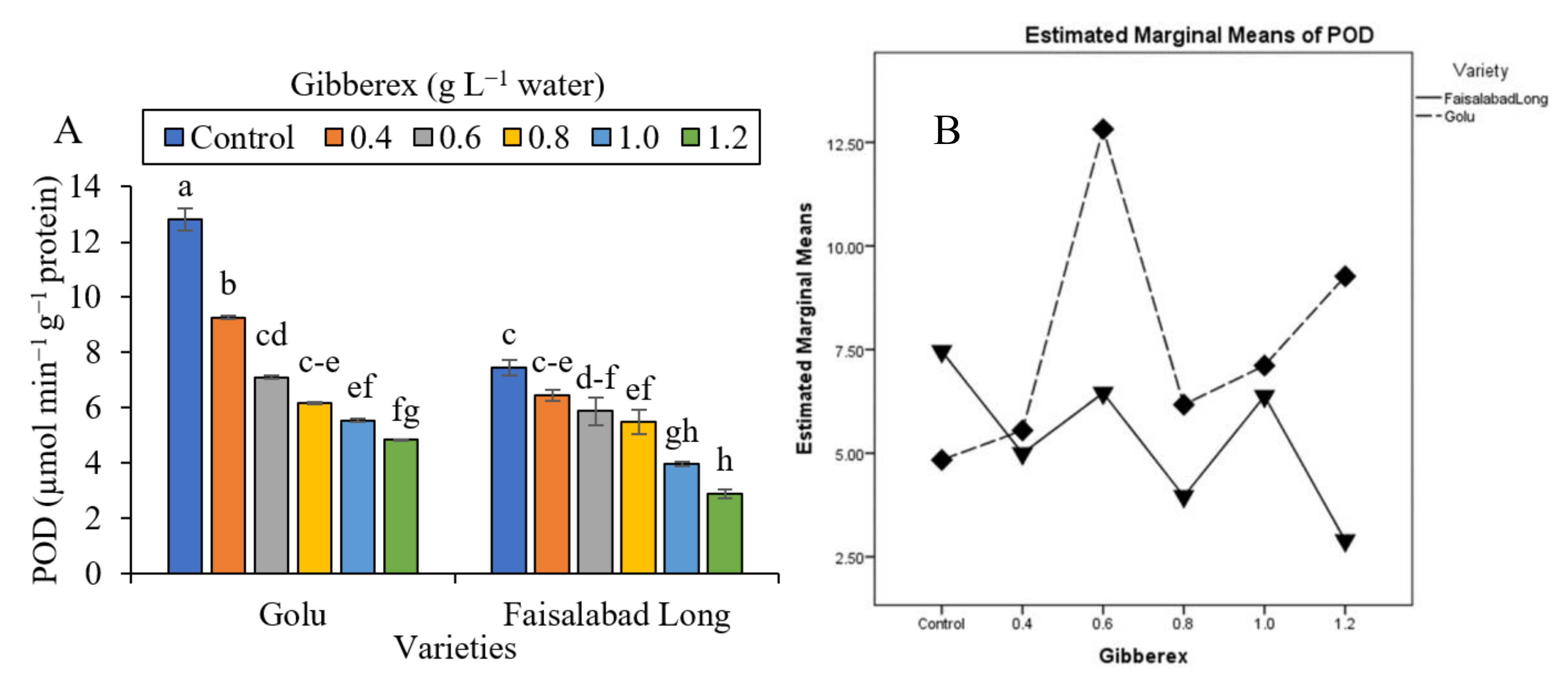

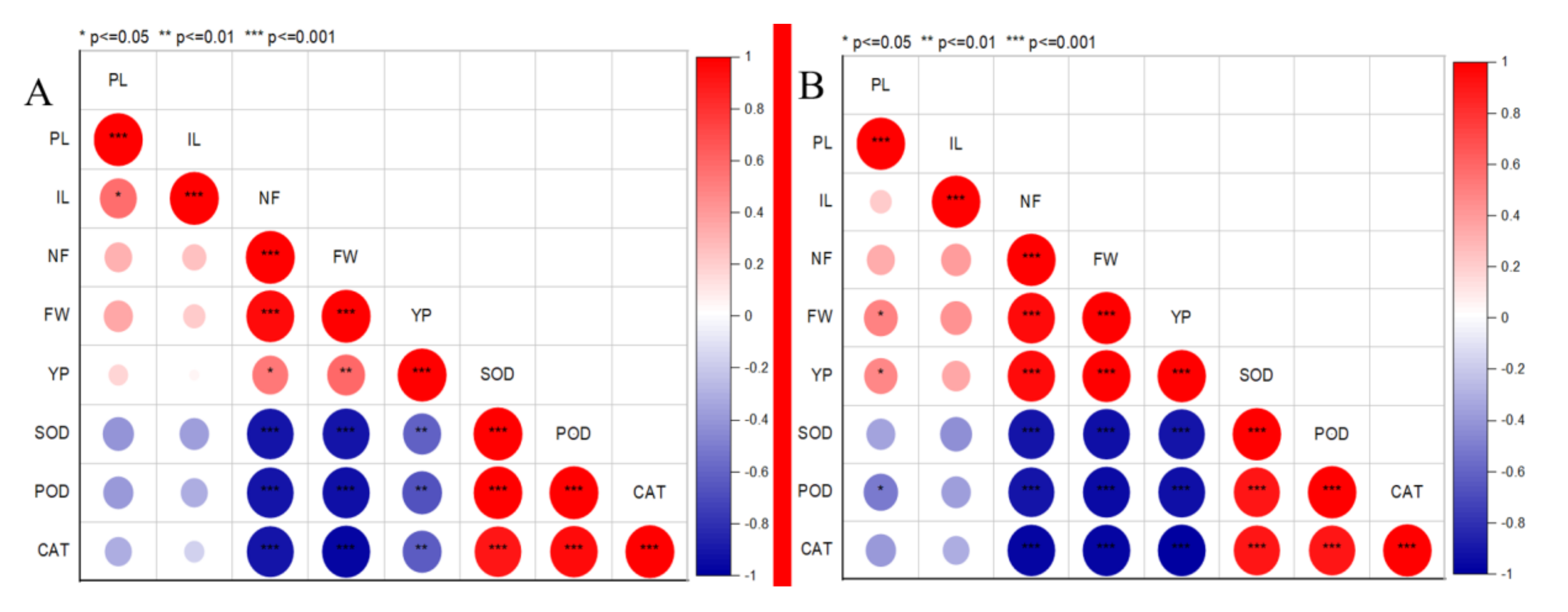
| Soil | Units | Value |
|---|---|---|
| Texture | - | Loam |
| pH | - | 8.02 |
| EC | dS m−1 | 2.47 |
| Organic matter | % | 0.65 |
| Organic N | % | 0.024 |
| Available P | mg Kg−1 | 6.54 |
| Extractable K | mg Kg−1 | 165 |
Publisher’s Note: MDPI stays neutral with regard to jurisdictional claims in published maps and institutional affiliations. |
© 2020 by the authors. Licensee MDPI, Basel, Switzerland. This article is an open access article distributed under the terms and conditions of the Creative Commons Attribution (CC BY) license (http://creativecommons.org/licenses/by/4.0/).
Share and Cite
Abbas, M.; Imran, F.; Iqbal Khan, R.; Zafar-ul-Hye, M.; Rafique, T.; Jameel Khan, M.; Taban, S.; Danish, S.; Datta, R. Gibberellic Acid Induced Changes on Growth, Yield, Superoxide Dismutase, Catalase and Peroxidase in Fruits of Bitter Gourd (Momordica charantia L.). Horticulturae 2020, 6, 72. https://doi.org/10.3390/horticulturae6040072
Abbas M, Imran F, Iqbal Khan R, Zafar-ul-Hye M, Rafique T, Jameel Khan M, Taban S, Danish S, Datta R. Gibberellic Acid Induced Changes on Growth, Yield, Superoxide Dismutase, Catalase and Peroxidase in Fruits of Bitter Gourd (Momordica charantia L.). Horticulturae. 2020; 6(4):72. https://doi.org/10.3390/horticulturae6040072
Chicago/Turabian StyleAbbas, Mazhar, Faisal Imran, Rashid Iqbal Khan, Muhammad Zafar-ul-Hye, Tariq Rafique, Muhammad Jameel Khan, Süleyman Taban, Subhan Danish, and Rahul Datta. 2020. "Gibberellic Acid Induced Changes on Growth, Yield, Superoxide Dismutase, Catalase and Peroxidase in Fruits of Bitter Gourd (Momordica charantia L.)" Horticulturae 6, no. 4: 72. https://doi.org/10.3390/horticulturae6040072







